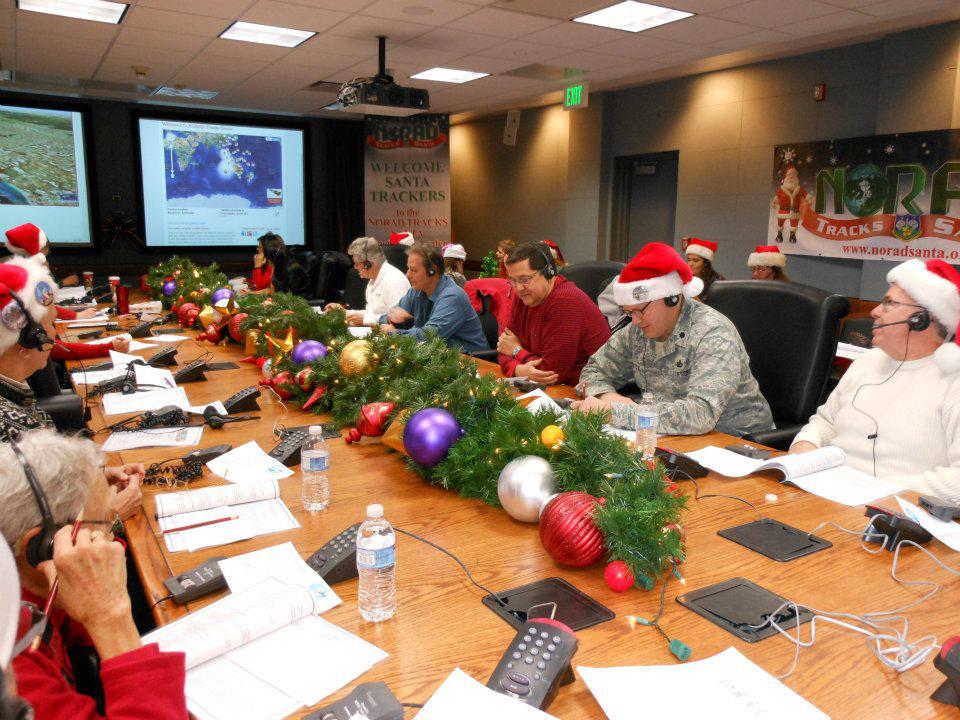
Volunteers at NORAD’s Live Operations Center take calls from people interested in tracking Santa during his 2014 Christmas travels. (NORAD Public Affairs)
Millions of people tracked Santa’s travels around the globe this Christmas, thanks to NORAD Tracks Santa, a non-profit program that provides updates on his whereabouts with a bit of imagination, some tech wizardry, and a lot of heart.
It all starts in early April, when NORAD – the North American Aerospace Defense Command – assembles its volunteers and partners to start charting Santa’s journey.
“We start out pulling together sort of where we would think that Santa traveling at the speed of starlight would … have to go to actually make it around the world to reach the billions and billions of kids,” said NORAD’s Chief of Integrated Communications, Michael Kucharek.
NORAD Tracks Santa 2014
- 21.8 million unique website visits from 234 countries between December 1-30
- 1,500 volunteers manning the Live Operations Center for 23 hours received 134,970 calls
- 1.5 million mobile downloads of NORAD’s Santa tracker app
- 65 contributors helped, including Microsoft, Verizon, HP, and many more
Moving from the most eastern part of the globe westward, the tracking team picks various places on the map that Santa will visit before his journey ends in Honolulu, Hawaii. They determine how often they want Santa tracked on December 24 and add his arrival and departure times to the map.
“We plotted in the times and then we lined up those times and locations,” said Kucharek. “So we do the front-end work and then we push that to Microsoft who renders that so that it is automatic to people on [December] 24, so that they see as Santa goes along how that’s actually done.”
Microsoft, NORAD’s prime partner, uses the data to render the tracking map. Santa and his sleigh, led by the famous Rudolph, the red-nosed reindeer, are then placed in their proper location on the map.
As many as 70 other partners provide assistance on everything from the 2-D and 3-D website and SantaCams, to mobile apps and social media.
NORAD and its partners meet on a regular basis through the end of November and intensify their collaboration to determine how to take the project to the next level.
“They are the people that actually make all this technology tick and tock and making sure that Santa is represented on the globe according to his location, using what we plot out, starting very early on,” said Kucharek.
All the data – locations, arrival and departure times – are then fed to NORAD’s ground-based radars.
Once Santa leaves the North Pole, the radars are then able to identify the shape of his sleigh, its harnesses and reindeer.

For 60 years, NORAD fighter jets have intercepted Santa many times. When the jets intercept Santa, they tip their wings to say, “Hello Santa! – NORAD is tracking you again this year!” (NORAD Public Affairs)
“All those are things that a ground-based radar can see,” said Kucharek. “And then obviously we got Rudolph’s nose that provides an infrared signature that certain military satellites are able to pick up … But also those satellites on a day-to-day basis are used for a real world mission of spotting launches that may occur anywhere around the globe.”
When all the maps, trackers, cameras and countdown clocks are in place, NORAD Tracks Santa goes live on December 1, following a tradition started in 1958 by Colonel Harry Shoup, when a little girl misdialed NORAD’s number asking to speak with Santa.
NORAD still holds true to that tradition as way of “paying the goodwill forward” and putting smiles on people’s faces, as Kucharek put it.
“You’ve got second and third generations … of people that are now tracking Santa,” he said. “They get together during the December 24 evening and throughout the day just checking to see where Santa is. They do it as a family. It’s become a holiday tradition for a lot of people.”
